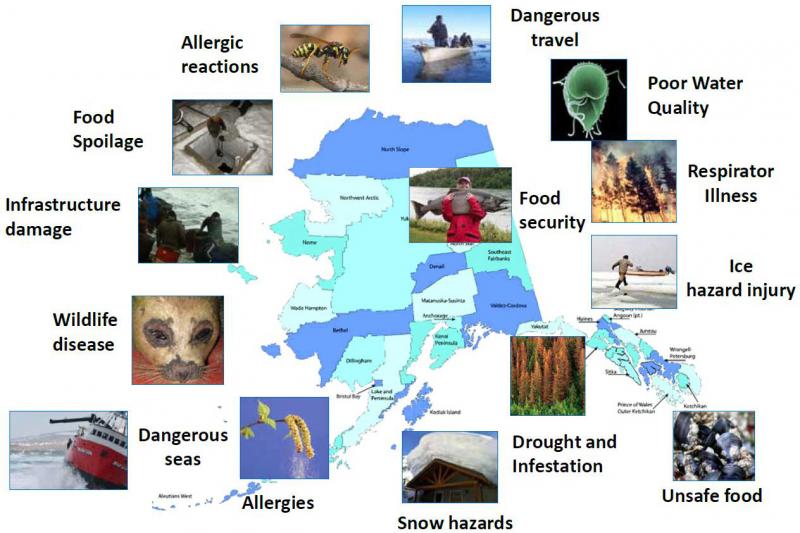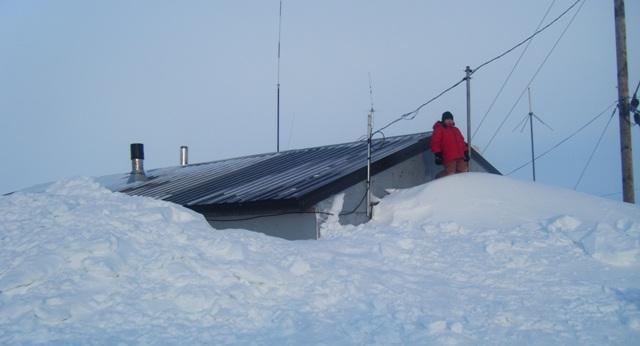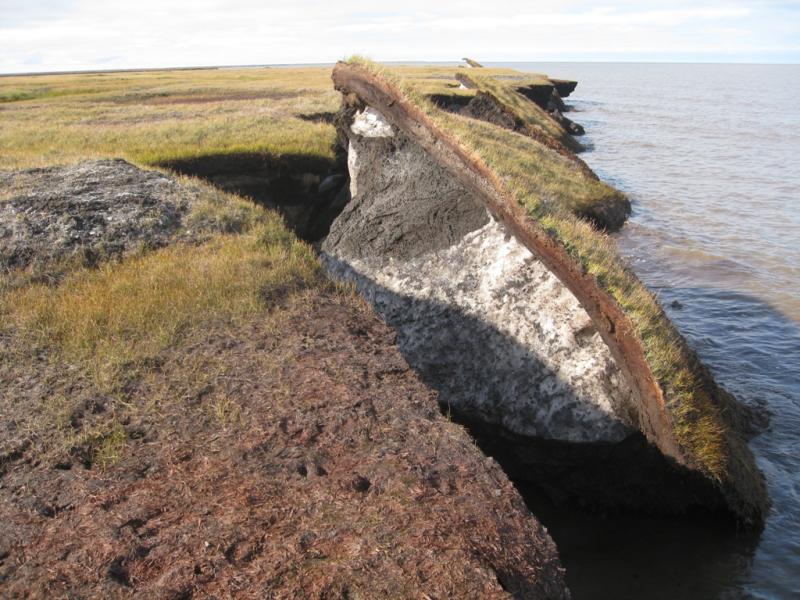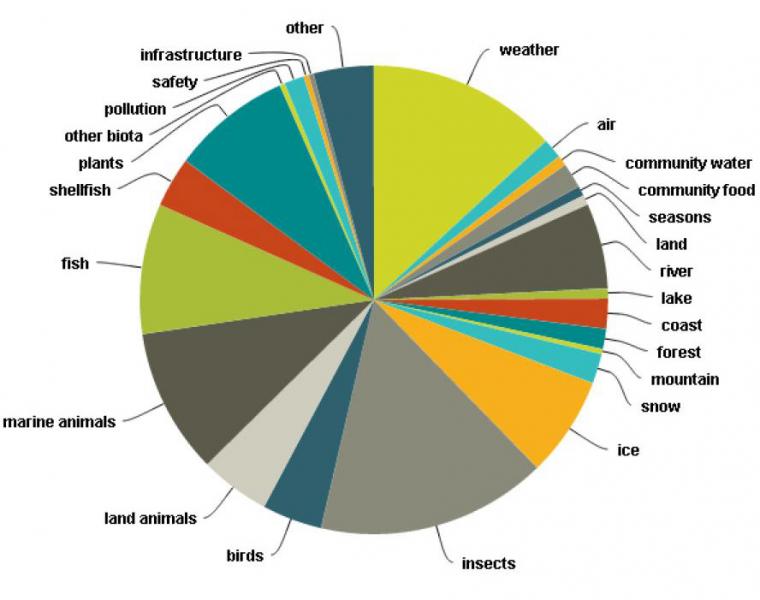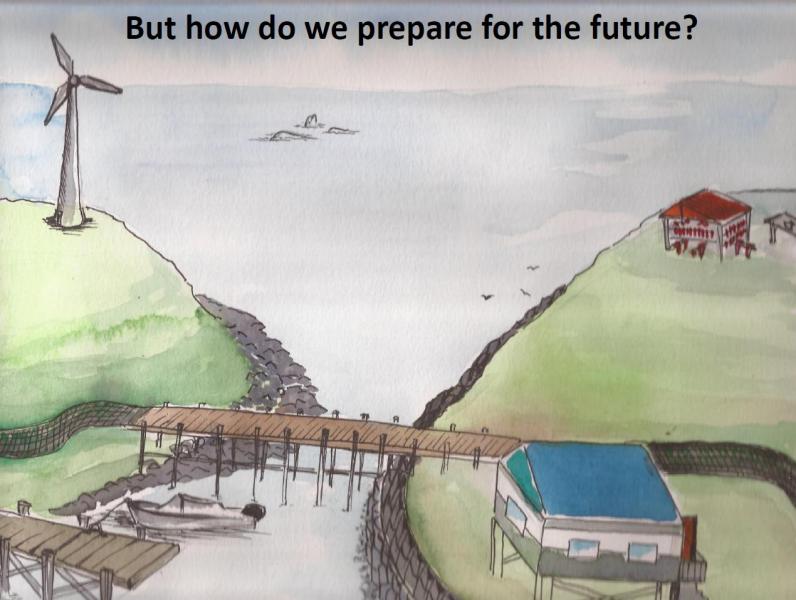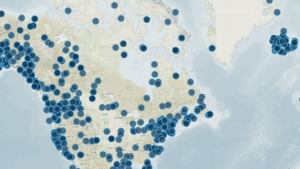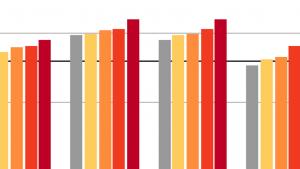Stressors and impacts
As emissions of heat-trapping bases accumulate in our atmosphere, Earth's polar regions are warming more quickly than at lower latitudes. The rapid environmental changes that result from this warming can have a significant impact on the physical and mental health of rural Alaskans: unpredictable weather and changes in the seasons have made harvesting food more difficult, hazardous, and stressful. The risk of physical injury has also increased, as poor ice, extreme weather, and coastal erosion bring new travel hazards. Increasingly difficult harvest conditions for fish, shellfish, berries, caribou, and sea mammals have also increased concerns about food security. Additionally, declines in snow pack, the threat of drought, changes in lake and river conditions, and damage and disruptions to community water systems have prompted concerns of water security. The climate-related challenge faced by Alaska’s tribal health system is to recognize new health stressors and community vulnerabilities, and then find healthy adaptation strategies in an increasingly uncertain future.
Linking climate and health
Since 1997, the Alaska Native Tribal Health Consortium (ANTHC) has operated a non-profit, statewide system of health services for more than 143,000 Alaska Native Villages and Native American Tribes. The group is the largest tribal self-governance organization in the United States. In 2009, ANTHC established the Center for Climate and Health to help people understand climate change impacts on community health and work to address them.
To help raise awareness about the connections between climate change and community health, ANTHC uses a variety of communication and education products.
- ClimeMap is an online product used to track press reports of climate change-related events around the circumpolar north. It is a reference for emerging threats and an archive of events that have occurred at the community, regional, and international level.
- The LEO Network (see below) is another map tool used for tracking local observation of environmental events and connecting communities with technical resources.
- Comprehensive climate vulnerability analyses with health assessments also increase awareness among Alaska Native communities about indirect linkages between climate and health.
- Topic-specific climate bulletins provide information about emerging climate change challenges.
- An e-journal, Northern Climate Observer, provides weekly access to other map tools, updates, assessments, and bulletins, as well as links to current stories in the press about climate change in the north.
The Local Environmental Observer (LEO) Network: The eyes, ears, and voice of environmental change
In 2011, with funding from the U.S. Environmental Protection Agency, ANTHC launched the Local Environmental Observer (LEO) Network (see link at right, under Tools). The purpose of the LEO Network is to help raises awareness about climate and other drivers of environmental change and to connect communities with technical resources. LEO connects local and traditional knowledge keepers, scientists, agencies, and other technical experts to document unusual plants and wildlife, extreme weather, erosion, flooding, droughts, wildfire, and other events with implications for community health. LEO has a youth component, and the network is expanding into other regions of the U.S. and Canada. LEO Youth also report unique and unusual environmental events in their communities. LEO observers, known as “LEOs,” help Alaska Native communities to document impacts, identify emerging threats, and plan appropriate responses with the aid of a network of topic experts.
Seven Generations: Environmental planning with climate considerations for long-term sustainability
Many Tribes and Alaska Native Villages specifically plan for future generations in decision making by focusing on the seventh-generation principle, as described by Orondaga Chief Oren Lyons: "When you sit and you council for the welfare of the people, think not of yourself nor of your family nor even your generation. Make your decisions on behalf of the seventh generation coming. Those faces looking up from the earth, layer upon layer waiting their time." If a generation is considered to be about 25 years, this requires projecting potential risks and side effects 175 years into the future.
Lyons, O. April 2008. Oren Lyons: Looking Toward the Seventh Generation. Presentation, American Indian Studies Program, University of Arizona, Tucson, Arizona.
To assist communities in planning for sustainability seven generations into the future, the Seven Generations (7G) planning guide and workshops assist Alaska Native Village participants in raising awareness of climate and environmental impacts (see the link at right, under Tools). The 7G environmental planning process helps communities identify and assess climate-related impacts and consider ways to improve the environment that can help maintain the health and welfare of people tied closely to the land and its resources. Building community strength to identify and solve climate issues in this way can lead to healthier, more sustainable Alaska Native communities.
Envisioning a future Alaska to plan and adapt to rapidly changing conditions
Mike Brubaker, Director of the Center for Climate and Health, has worked for years with Alaska Native communities to assess climate change impacts and implications for public health. Brubaker has identified several practical steps for a local climate change adaptation campaign, which are applied in the different components of ANTHC’s programs and services:
- Raise awareness
- Engage in climate dialogue
- Identify your information network
- Share environmental observations
- Describe climate baseline
- Identify climate vulnerabilities
- Develop targeted adaptation strategies
ANTHC has partnered with the U.S. Centers for Disease Control and Prevention to form the One Health Group to understand the "One Health” connections between environmental health, plant and animal health, and human health. The group—which includes a range of health, environment, and biota professionals—meets regularly to discuss emerging One Health issues, to consider events that are indicative of environmental and climate change, and to provide a forum for identifying areas of common interest and collaborations.
The ANTHC Center for Climate and Health is helping communities become more aware of how climate change is impacting the environment and public health. This is the first step in developing effective plans and adaptation strategies and resource partnerships.

